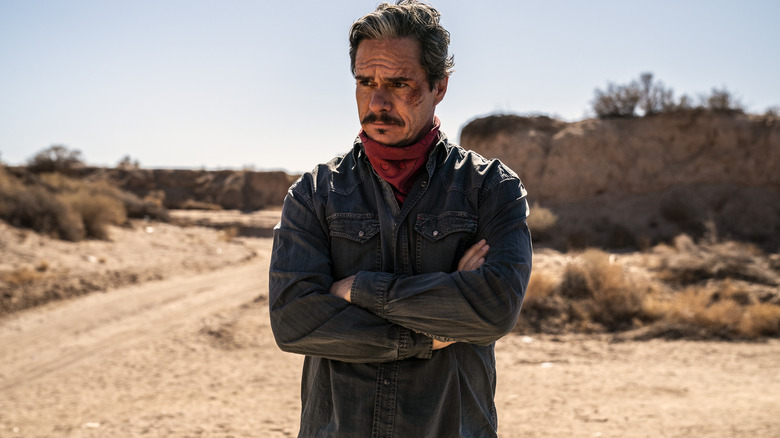Introducing Lalo To Better Call Saul Solved One Of The Writers' Biggest Problems
By their very nature, prequels can run the risk of becoming creative dead-ends — or at least creative cul-de-sacs, forcing writers into wheel-spinning holding patterns. And because audiences already know what's going to happen later on, the job of the writers subsequently ends up that much harder to do successfully. How do you maintain a consistently high level of stakes when the overall trajectory of the main character is largely set in stone and their survival is not in question whatsoever? That conundrum only deepens when it happens to involve a character as odious and loathsome (though always entertaining!) as Saul Goodman (Bob Odenkirk), criminal lawyer extraordinaire with a penchant for defending some of the worst and most obviously guilty members of the New Mexico criminal landscape.
Though many of the challenges inherent in creating "Better Call Saul" come as a result of its place in the "Breaking Bad" universe's timeline (roughly a few years before the events of "Breaking Bad" season 1), another major obstacle in the path of co-creators Vince Gilligan and Peter Gould stemmed from living in the shadow of the acclaimed original series. Anything having to do with Saul Goodman's origins as the far more mild-mannered and decent Jimmy McGill would inevitably pale in comparison to the almost mythological downfall of Bryan Cranston's Walter White (one of the absolute best episodes in the entire show is literally titled "Ozymandias," after all). But what about the difficulty in bringing back the parent show's most intimidating villain, Gustavo Fring?
One side effect of having Giancarlo Esposito reprise his role as the cartel drug kingpin, sworn enemy of the rival Salamanca family, involved creating another antagonist who could actually stand toe-to-toe with him and his fixer, Mike Ehrmantraut (Jonathan Banks). Enter Tony Dalton's Lalo Salamanca, a character only briefly name-dropped by Saul in "Breaking Bad" who has been fleshed out into playing an integral role in "Better Call Saul."
'A kind of cartel Errol Flynn'
Call it the Gus Fring Problem. Some characters are written to play things close to the vest while remaining so outwardly calm that they can pose a uniquely frustrating challenge to those bearing the responsibility to actually write them. In a conversation with Collider soon after the season 5 finale of "Better Call Saul" originally aired, Peter Gould touched on how the introduction of Lalo helped them solve the Gus Fring of it all. After mentioning how "tricky" Fring is to write and the need for a "worthy" foe to measure up, Gould had this to say about Tony Dalton's Lalo.
"And we thought about, 'Well, who's a different breed of cat from the one that we've seen before? What's a different approach that we haven't seen?' And we just thought of this guy who's enjoying himself. He takes pleasure in life, he takes pleasure in his abilities. He is a cold-blooded murderer also, but that doesn't mean he can't enjoy life. And Tony makes him into a kind of cartel Errol Flynn. You know, he's dashing, he's handsome, he's perceptive, and he is every inch a worthy opponent for Gustavo Fring and for Mike Ehrmantraut."
The aura and tangible danger of Gus Fring was well-established throughout "Breaking Bad," even when accounting for the character's ultimate demise. But leave it to the uniquely menacing Lalo to help counterbalance that presence and pose a convincing threat to Fring's operations.
Season 5 ends with the frightening image of Lalo, having narrowly survived a Fring-ordered hit, on the warpath and bent on revenge. Such a moment could only have been achieved through carefully building him up as a threat to be reckoned with throughout prior seasons. We're about to see the fruit of all that careful plotting, as season 6 of "Better Call Saul" finally premieres tonight on AMC.

